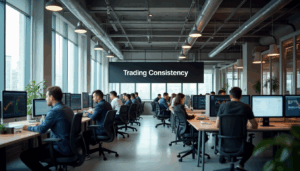Market Structure in Forex: Pro Strategies for 2025 Success


Forex trading is massive and getting even bigger, with over $6.6 trillion moving through the global market every single day. But here’s the shocker. Most traders ignore how the market’s real structure actually works and end up swimming with sharks. Knowing the inside details of market structure can flip the script in 2025, letting traders catch moves that others never even see coming.
Table of Contents
- Key Elements Of Market Structure In Forex
- Applying Market Structure To Advanced Trading
- Common Pitfalls And Risk Management Tactics
- Capital Scaling With Proven Market Structure Methods
Quick Summary
| Takeaway | Explanation |
|---|---|
| Diverse Market Participants | The forex market comprises various participants including central banks, commercial banks, institutional investors, and retail traders, each impacting currency valuations in unique ways. |
| Importance of Liquidity | Liquidity is crucial for effective trading, with major currency pairs demonstrating higher liquidity, resulting in tighter bid-ask spreads and stable trading conditions. |
| Leveraging Technology for Trading | Advanced algorithmic trading systems analyze market data rapidly, enabling traders to execute strategies with precision and exploit minor market inefficiencies. |
| Strategic Risk Management | Effective risk management involves understanding market structure and applying techniques like position sizing, stop-loss orders, and comprehensive downside protection to mitigate losses. |
| Structured Capital Scaling | Capital scaling requires disciplined strategies using mathematical frameworks and algorithmic management to ensure systematic growth without significant risks. |
Key Elements of Market Structure in Forex
Understanding the intricate market structure in forex is crucial for traders seeking consistent success in 2025. The forex market represents a complex global ecosystem where currency values fluctuate based on multiple interconnected elements that define its fundamental architecture.

Market Participants and Their Roles
The forex market functions through a diverse network of participants, each contributing to its dynamic nature. Central banks play a pivotal role by setting monetary policies that directly impact currency valuations. Commercial banks facilitate the majority of international currency transactions, providing liquidity and executing large-scale trades. Institutional investors like hedge funds and pension funds contribute significant trading volumes, while retail traders increasingly participate through online trading platforms.
According to research from the Bank for International Settlements, the global forex market processes over $6.6 trillion in daily transactions, highlighting the immense scale and complexity of these interactions. Each participant brings unique motivations – from hedging economic risks to speculative trading – which collectively shape currency price movements.
To clarify the different types of forex market participants and their main roles, here is a summary table:
| Participant Type | Main Function | Example Impact on Market |
|---|---|---|
| Central Banks | Set monetary policy, intervene in currency markets | Adjust currency valuation |
| Commercial Banks | Provide liquidity, conduct large FX transactions | Influence short-term movements |
| Institutional Investors | Trade large volumes for investment or hedging purposes | Affect long-term trends |
| Retail Traders | Trade for speculation via online platforms | Add to daily trading activity |
| Corporations | Hedge currency risk for international business | Trigger real market demand |
Market Microstructure and Liquidity Dynamics
The market structure in forex is fundamentally defined by its microstructure, which encompasses how trades are executed, priced, and processed. Liquidity represents a critical component, determining how easily currencies can be bought or sold without substantial price disruptions. High liquidity typically indicates tighter bid-ask spreads and more stable trading conditions.
Expert analysis from the International Monetary Fund suggests that liquidity varies significantly across different currency pairs. Major pairs like EUR/USD demonstrate extremely high liquidity, while exotic pairs might experience more pronounced price fluctuations. Traders must understand these nuanced liquidity characteristics to develop robust trading strategies.
Technological Infrastructure and Trading Mechanisms
Modern forex markets are fundamentally technology-driven, with sophisticated electronic trading platforms enabling near-instantaneous global transactions. Advanced algorithmic trading systems now account for a substantial portion of daily trading volume, introducing complex computational strategies that can execute trades within milliseconds.
Trading mechanisms have evolved to include various order types – market orders, limit orders, and stop orders – each offering traders precise control over their market interactions. Learn more about advanced trading techniques through comprehensive evaluation processes that test trader skill and adaptability.
The interplay between human decision-making and technological infrastructure continues to reshape forex market structure, creating an environment where adaptability and continuous learning become essential for sustained trading success. Understanding these key elements provides traders with a strategic foundation for navigating the complex global currency marketplace in 2025 and beyond.
Applying Market Structure to Advanced Trading
Successful forex trading requires more than basic market knowledge – it demands a sophisticated understanding of how market structure can be strategically leveraged to develop advanced trading approaches. Professional traders recognize that deep market structure insights provide critical competitive advantages in the complex global currency marketplace.
Strategic Order Flow Analysis
Order flow represents a sophisticated technique for understanding market dynamics beyond traditional price action. Research from advanced financial modeling reveals compelling evidence of long memory in forex markets, with trading patterns demonstrating predictable behavioral characteristics. Traders who analyze order flow can identify hidden market sentiment and potential price movements before they become apparent to the broader market.
Professional traders utilize advanced order flow techniques like volume profile analysis and market depth interpretation. These methods allow them to understand the underlying supply and demand dynamics that drive currency pair movements. By tracking institutional trading volumes, monitoring large order placements, and detecting subtle market imbalances, traders can develop more nuanced and predictive trading strategies.
Algorithmic Trading and Computational Strategies

Modern forex trading increasingly relies on sophisticated algorithmic approaches that exploit minute market structure inefficiencies. A groundbreaking study introduced a game-theoretic model demonstrating how information asymmetry creates unique trading opportunities. Algorithmic systems can process complex market data exponentially faster than human traders, identifying and executing trades within milliseconds.
Key computational strategies include statistical arbitrage, where algorithms detect and exploit temporary pricing discrepancies across different currency pairs. Machine learning models can now analyze massive datasets to predict short-term market movements with increasing accuracy. Traders who master advanced trading techniques can develop robust systems that adapt to changing market conditions.
Risk Management Through Market Structure Insights
Understanding market microstructure is fundamental to effective risk management. Professional traders recognize that market structure provides critical insights into potential volatility and trading risks. Expert analysis from high-frequency trading research indicates that most arbitrage opportunities are extremely short-lived, typically lasting less than 5 seconds.
This temporal constraint demands precise risk management strategies. Successful traders develop sophisticated risk models that account for market liquidity, order execution speeds, and potential slippage. By integrating detailed market structure analysis into their risk frameworks, traders can create more resilient and adaptive trading approaches.
Applying market structure to advanced trading is not about predicting markets with absolute certainty, but developing a probabilistic understanding of complex market dynamics. The most successful traders view market structure as a dynamic, evolving ecosystem that requires continuous learning and strategic adaptation.
Common Pitfalls and Risk Management Tactics
In the complex world of forex trading, understanding potential risks and implementing robust management strategies are fundamental to long-term success. Professional traders recognize that avoiding common pitfalls requires a strategic approach grounded in comprehensive risk assessment and disciplined execution.
Information Asymmetry and Decision-Making Challenges
Research analyzing trading behaviors reveals significant challenges arising from information asymmetry in forex markets. Traders often encounter complex decision-making scenarios where access to superior information becomes a critical differentiator. This asymmetry can lead to substantial miscalculations if not carefully managed.
Key decision-making pitfalls include overconfidence, emotional trading, and failure to adapt to changing market conditions. Successful traders develop robust mental frameworks that prioritize objective analysis over intuitive responses. They implement strict trading protocols that minimize the impact of psychological biases, such as confirmation bias and loss aversion. By creating predefined trading rules and maintaining disciplined risk management strategies, traders can mitigate the negative impacts of subjective decision-making.
To help traders identify and address common decision-making pitfalls, here is a checklist table summarizing frequent challenges and mitigation approaches:
| Pitfall | Description | Mitigation Approach |
|---|---|---|
| Overconfidence | Excessive belief in trading skill or knowledge | Follow predefined rules and risk limits |
| Emotional Trading | Making trades based on fear or greed | Use objective analysis and control emotions |
| Failure to Adapt | Not adjusting to changing market conditions | Continuously evaluate and update strategy |
| Confirmation Bias | Seeking information that supports own view | Seek diverse opinions and data |
| Loss Aversion | Holding losing trades too long | Stick to stop-loss and exit rules |
Strategic Risk Mitigation Techniques
An empirical analysis of corporate currency risk management highlights the critical importance of developing comprehensive risk mitigation strategies. Professional traders utilize multiple techniques to protect their capital and minimize potential losses. These strategies include precise position sizing, implementing stop-loss orders, and maintaining diversified trading portfolios.
Risk management goes beyond simple protective measures. Advanced traders employ sophisticated techniques like correlational analysis to understand potential market interactions. They develop complex hedging strategies that account for multiple market variables, creating resilient trading approaches that can withstand unexpected market fluctuations. Learn more about advanced risk management techniques through comprehensive trading evaluations that test trader adaptability and strategic thinking.
Liquidity and Execution Risk Management
Market making research in forex markets illuminates the complex challenges of managing liquidity and execution risks. Traders must navigate intricate market dynamics that involve balancing immediate trading opportunities with long-term portfolio stability. This requires a nuanced understanding of market microstructure and the ability to make rapid, informed decisions.
Effective risk management involves continuous monitoring of market conditions, maintaining adequate capital reserves, and developing flexible trading strategies. Traders must be prepared to adjust their approaches quickly, recognizing that market conditions can change rapidly. This demands a combination of technological sophistication, analytical skills, and psychological resilience.
Navigating the forex market’s complex risk landscape requires more than technical knowledge – it demands a holistic approach that integrates strategic thinking, emotional intelligence, and continuous learning. The most successful traders view risk management not as a constraint but as a critical component of their overall trading methodology, enabling them to create sustainable and adaptive trading strategies.
Capital Scaling with Proven Market Structure Methods
Capital scaling in forex trading represents a sophisticated approach to systematically growing trading accounts while maintaining rigorous risk management. Professional traders understand that successful capital scaling requires more than intuitive decision-making – it demands a strategic methodology deeply rooted in comprehensive market structure analysis.
Mathematical Scaling Frameworks
Advanced research in high-frequency finance has uncovered 12 empirical scaling laws that provide profound insights into foreign exchange market dynamics. These mathematical models reveal consistent patterns across multiple currency pairs, enabling traders to develop more predictable and systematic scaling strategies. By understanding these underlying statistical relationships, traders can create more robust approaches to incrementally increasing their trading capital.
Successful capital scaling involves implementing disciplined position sizing techniques that adapt to changing market conditions. Traders utilize sophisticated risk-reward ratio calculations, ensuring that each trade maintains a carefully calibrated risk profile. This approach prevents catastrophic losses while creating opportunities for exponential account growth. Techniques like geometric position sizing and fractional Kelly criterion methods allow traders to dynamically adjust their trading volumes based on observed market performance.
To highlight various capital scaling techniques mentioned, here is a summary table comparing key mathematical scaling strategies:
| Scaling Technique | Description | Benefit |
|---|---|---|
| Geometric Position Sizing | Increases position size proportionally to profits | Enables exponential growth |
| Fractional Kelly Criterion | Allocates optimal trade size based on probability | Balances risk and reward |
| Fixed Percentage Risk | Risks set % of capital on each trade | Ensures consistent risk levels |
| Risk-Reward Ratio Targeting | Selects trades with favorable risk/reward outcomes | Filters for quality setups |
Algorithmic Capital Management
Research from global financial markets highlights the decentralized nature of forex trading, which presents unique opportunities for algorithmic capital scaling. Modern traders leverage advanced computational models that can analyze market microstructures and execute sophisticated trading strategies with unprecedented precision. These algorithmic approaches enable rapid identification of market inefficiencies and potential scaling opportunities.
Algorithmic trading systems can process vast amounts of market data exponentially faster than human traders, detecting subtle market structure nuances that might otherwise remain unnoticed. By integrating machine learning techniques, these systems continuously refine their strategies, adapting to evolving market conditions. Traders who explore advanced evaluation processes can develop more sophisticated algorithmic approaches that systematically scale trading capital.
Risk-Adjusted Capital Progression
Risk-adjusted capital progression represents a critical component of sustainable forex trading strategies. Professional traders recognize that consistent growth requires more than aggressive trading – it demands a nuanced understanding of market dynamics and precise risk management. This approach involves creating a structured framework that balances potential returns with comprehensive risk mitigation.
Key risk-adjusted scaling strategies include implementing strict drawdown limits, maintaining diversified trading portfolios, and developing multi-tiered risk management protocols. Traders continuously monitor their performance metrics, using statistical analysis to refine their approaches. By treating trading as a probabilistic endeavor rather than a speculative activity, they can create more predictable pathways for capital growth.
Successful capital scaling in forex is not about making massive, high-risk trades, but developing a systematic, data-driven approach that prioritizes consistent performance. The most effective traders view capital scaling as a long-term strategic process, emphasizing disciplined execution, continuous learning, and adaptive risk management. By integrating advanced market structure insights with sophisticated computational techniques, traders can transform their trading from a high-risk activity into a structured, methodical approach to financial growth.
Frequently Asked Questions
What is market structure in forex trading?
Market structure in forex trading refers to the framework that defines how currency transactions occur, including the roles of different market participants, liquidity dynamics, and trading mechanisms.
Why is understanding market participants important for forex trading?
Understanding market participants such as central banks, commercial banks, institutional investors, and retail traders helps traders to gauge their influence on currency valuations and market movements, enabling more informed trading decisions.
How can traders leverage technology in forex trading?
Traders can leverage technology through algorithmic trading systems, which analyze market data rapidly and execute trades precisely, allowing them to exploit minor market inefficiencies and enhance their trading strategies.
What are the key risk management strategies in forex trading?
Key risk management strategies include position sizing, implementing stop-loss orders, and maintaining diversified portfolios to protect capital and mitigate potential losses in the volatile forex market.
Transform Your Forex Market Structure Knowledge Into Real Trading Capital
You have just learned how understanding market participants, liquidity dynamics, and advanced trading techniques can give you a true edge in the evolving forex landscape. But even skilled traders often struggle to scale up due to limited capital and strict risk requirements. It is not enough to know the theory. The real opportunity comes when you apply your expertise where it matters most.

If you are ready to put your market structure strategies to the test, take on a transparent evaluation challenge and qualify for a funded trading account. Showcase your skills in a real-world environment with institutional-grade trading conditions and flexible scaling programs. Visit https://funded.earnexprime.com now to start your journey. This is your chance to turn advanced forex knowledge into meaningful trading capital and set yourself up for success in 2025.






